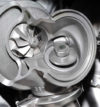
Automotive
Wear protection for automotive
In the construction and design of vehicle components, wear-related challenges arise in many cases. Our BOROCOAT®, nitriding and BORINOX® processes open up solutions!
Borocoat® protects against:
Extreme abrasive wear
High temperature wear up to 900 °C (1650° F)
Nitriding protects against:
Abrasive wear
Increases fatigue strength
BORINOX® protects stainless steel from:
Abrasive wear
Cold welding
Increases fatigue strength
FIND THE RIGHT SOLUTION!
Let our professionals advise you – from material selection to optimum wear protection.

Our solutions in use
Borocoat® – Nitriding – BORINOX® – Materials
The three processes allow us to offer a solution for almost every steel material and special alloy.
- Cast iron
- Cast steel
- CARBON STEEL
- Quenched and tempered steel
- Corrosion resistant steel
- DUPLEX STEEL
- Stellite
- Inconel®, Hastelloy®, Haynes®
- Nitriding steel
More info
Data Sheet
BOROCOAT®
Information about the process
Technical Recommendations
BOROCOAT®
Tips for successful heat treatment
Data Sheet
NITRIDING
Information about the process – coming soon
Technical Recommendations
NITRIDING
Tips for successful heat treatment – coming soon
Data Sheet
BORINOX®
Information about the process
Technical Recommendations
BORINOX®
Tips for successful heat treatment
BOROCOAT® in automotive engineering
In the construction and design of vehicle components, wear-related challenges arise in many cases.
Due to the large number of moving parts and the fact that vehicles are generally exposed to wind and weather, there are numerous points of attack for wear mechanisms. Engines and turbocharger components in particular are susceptible to abrasive, high-temperature, vibratory fretting wear and hot gas corrosion.
One possibility for engineers in vehicle construction to prevent and minimize wear is boronizing. In the following, a few application areas that are frequently affected by wear are presented as examples.BOROCOAT® - Parts affected by wear in vehicle construction
In automotive engineering, and there especially in turbocharger construction, the use of the BOROCOAT® process is a proven method of wear protection. The boride coatings are temperature-resistant up to 1000° C (1830° F) and offer excellent protection for parts made of nickel-based alloys. For example, components of modern variable turbine geometry (VTG) superchargers such as guide vanes and variable pitch rings are borided. Boronizing prevents wear of the shift gate and ensures operational reliability for the lifetime of an automobile.
Further applications are found in turbocharger shift linkages, where the positive properties of boride coatings are particularly evident on the hot gas side of the turbocharger.
BORINOX® - Opportunities for hardened stainless steel in automotive applications
In automotive engineering, many components are exposed to high stresses. Abrasive wear, cold welding and fatigue of neuralgic points are the problem areas where automotive manufacturers and suppliers need high-quality solutions to increase the service life of the components used. The BORINOX® process can help to increase the durability of the stainless steel materials used in many applications. In the following, we present some frequently affected components.BORINOX® - Stainless steel hardening for turbochargers
In turbocharger manufacturing, for example, foreign body damage to the compressor wheel and compressor is a common problem. Materials loosened from the crankcase ventilation can lead to damage, and abrasive wear on the compressor blades is also a common problem. Effects can include smoke generation, loss of power, noise generation and damage to the intercooler. Other affected parts can include turbine wheels and turbine housings. Many of these problems can be reduced or eliminated altogether by hardening the components used. In principle, turbochargers are not wearing parts and, with regular inspection and maintenance, should last the life of the engine. Components refined with BORINOX® contribute to this goal. The use of hardened stainless steel for coupling rods in and on the turbocharger is particularly promising.
Nitriding - Other products relevant to the automotive industry
Bearing journals are frequently affected by wear due to fretting corrosion. Bearing journals are used to connect various components together and, due to their function, are frequently affected by abrasion and surface disruption. Similar problems can also occur with other products used to connect components. Examples include link pins, link plates, disc springs and coupling rods.







